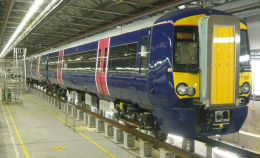Posted 2nd April 2009 | No Comments
Industry pulls together to meet Thameslink deadline

IN A huge team effort the rail industry pulled together to transfer trains from routes across the South and South East of England to keep the £5.5 billion Thameslink Programme on track.
First Capital Connect was due to receive 23 new four-car Electrostars from train maker Bombardier as part of a complex plan to help operate a new timetable from 22 March, thereby allowing the Thames-link upgrade work to go-ahead.
Moorgate was being closed to allow Network Rail to take out three platforms at London Blackfriars and begin rebuilding the station for 50 per cent longer 12-car trains as part of the upgrade project.
The timing of the Moorgate closure and the start of FCC’s new services was crucial, as extra trains had to be found to make up for the closure of the Blackfriars platforms.
But building of the new Electrostar trains needed for the new timetable had been delayed by up to three-and-a- half months, mainly due to supplier problems at Bombardier, and only three of the new trains have been delivered to FCC.
With the deadline for the closure of the Moorgate branch getting closer, urgent moves started to find the 20 extra trains needed by First Capital Connect.
Responding to the delay, the Department for Transport triggered a ‘cascade’ of coaches from other train operators, including Southern and Southeastern, to ensure sufficient trains to start the new timetable.
Southern has provided eight four-car Class 377 Electrostars from Brighton to Bedford services, while Southeastern has loaned four Class 465/466 Networkers to run four ser-vices a day from south of the river into and out of City Thameslink.
This is releasing four Class 319 units to work between Bedford and Brighton, and FCC has postponed refurbishment of this fleet to increase the number of trains available for the route.
The extra trains from Southern and Southeastern have increased capacity by almost 2,800 seats across morning and evening peaks – 616 short of the planned increase – and provided new journey opportunities between Sevenoaks, Orpington and Kentish Town, Luton and Bedford via Blackfriars and St Pancras Thameslink.
The number of trains running through central London has increased from eight to 15 an hour.
But FCC is concerned at the increased risk of potential disruption, having only three of the 10 planned spare trains to cover for failures and loaned trains running on unfamiliar infrastructure. And with many more passengers now interchanging with Tube services at Farringdon to reach Barbican and Moorgate, any train failures could create even worse congestion during peak hours.
The company has brought in additional staff to work at stations and in control rooms, and has contingency plans to deal with any problems. An extra rush-hour ‘crowd-buster’ service has been introduced to collect passengers for stations to Bedford from Farringdon at 6.16pm each weekday evening.
Bombardier’s director of communications Neil Harvey said: ”While we have been hit by component supply problems, as the main contractor we take full responsibility for the delay. Three new trains have so far been handed over and we are working hard to deliver the full fleet as quickly as possible.”
FCC managing director Elaine Holt said: “Delays to delivery of the Electrostars is a massive blow for our customers who will now have to wait until summer for the benefits of new air-conditioned trains and full capacity improvement.
“ We are advising customers to use City Thameslink instead of Farringdon where possible, and are pulling out all the stops to run a good service.”
